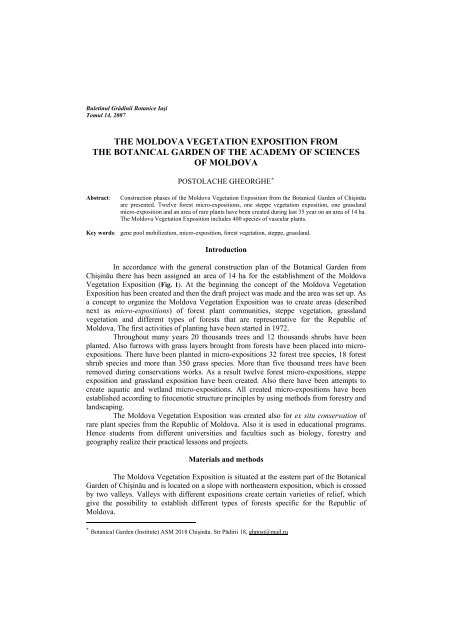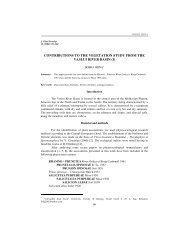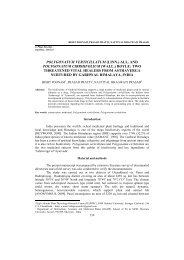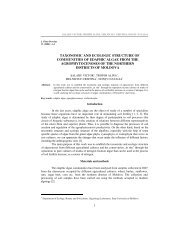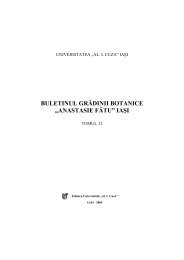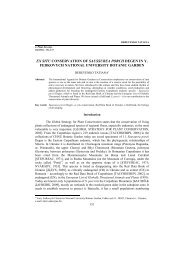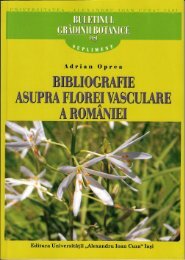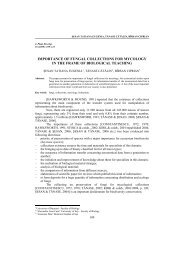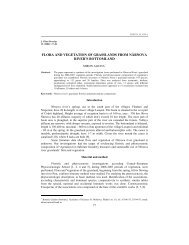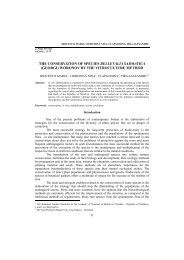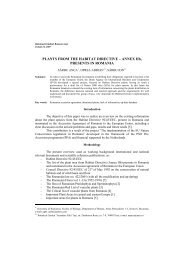the moldova vegetation exposition from - Journal of Plant ...
the moldova vegetation exposition from - Journal of Plant ...
the moldova vegetation exposition from - Journal of Plant ...
You also want an ePaper? Increase the reach of your titles
YUMPU automatically turns print PDFs into web optimized ePapers that Google loves.
Buletinul Grădinii Botanice Iaşi<br />
Tomul 14, 2007<br />
THE MOLDOVA VEGETATION EXPOSITION FROM<br />
THE BOTANICAL GARDEN OF THE ACADEMY OF SCIENCES<br />
OF MOLDOVA<br />
POSTOLACHE GHEORGHE ∗<br />
Abstract:<br />
Construction phases <strong>of</strong> <strong>the</strong> Moldova Vegetation Exposition <strong>from</strong> <strong>the</strong> Botanical Garden <strong>of</strong> Chişinău<br />
are presented. Twelve forest micro-<strong>exposition</strong>s, one steppe <strong>vegetation</strong> <strong>exposition</strong>, one grassland<br />
micro-<strong>exposition</strong> and an area <strong>of</strong> rare plants have been created during last 35 year on an area <strong>of</strong> 14 ha.<br />
The Moldova Vegetation Exposition includes 400 species <strong>of</strong> vascular plants.<br />
Key words: gene pool mobilization, micro-<strong>exposition</strong>, forest <strong>vegetation</strong>, steppe, grassland.<br />
Introduction<br />
In accordance with <strong>the</strong> general construction plan <strong>of</strong> <strong>the</strong> Botanical Garden <strong>from</strong><br />
Chişinău <strong>the</strong>re has been assigned an area <strong>of</strong> 14 ha for <strong>the</strong> establishment <strong>of</strong> <strong>the</strong> Moldova<br />
Vegetation Exposition (Fig. 1). At <strong>the</strong> beginning <strong>the</strong> concept <strong>of</strong> <strong>the</strong> Moldova Vegetation<br />
Exposition has been created and <strong>the</strong>n <strong>the</strong> draft project was made and <strong>the</strong> area was set up. As<br />
a concept to organize <strong>the</strong> Moldova Vegetation Exposition was to create areas (described<br />
next as micro-<strong>exposition</strong>s) <strong>of</strong> forest plant communities, steppe <strong>vegetation</strong>, grassland<br />
<strong>vegetation</strong> and different types <strong>of</strong> forests that are representative for <strong>the</strong> Republic <strong>of</strong><br />
Moldova. The first activities <strong>of</strong> planting have been started in 1972.<br />
Throughout many years 20 thousands trees and 12 thousands shrubs have been<br />
planted. Also furrows with grass layers brought <strong>from</strong> forests have been placed into micro<strong>exposition</strong>s.<br />
There have been planted in micro-<strong>exposition</strong>s 32 forest tree species, 18 forest<br />
shrub species and more than 350 grass species. More than five thousand trees have been<br />
removed during conservations works. As a result twelve forest micro-<strong>exposition</strong>s, steppe<br />
<strong>exposition</strong> and grassland <strong>exposition</strong> have been created. Also <strong>the</strong>re have been attempts to<br />
create aquatic and wetland micro-<strong>exposition</strong>s. All created micro-<strong>exposition</strong>s have been<br />
established according to fitocenotic structure principles by using methods <strong>from</strong> forestry and<br />
landscaping.<br />
The Moldova Vegetation Exposition was created also for ex situ conservation <strong>of</strong><br />
rare plant species <strong>from</strong> <strong>the</strong> Republic <strong>of</strong> Moldova. Also it is used in educational programs.<br />
Hence students <strong>from</strong> different universities and faculties such as biology, forestry and<br />
geography realize <strong>the</strong>ir practical lessons and projects.<br />
Materials and methods<br />
The Moldova Vegetation Exposition is situated at <strong>the</strong> eastern part <strong>of</strong> <strong>the</strong> Botanical<br />
Garden <strong>of</strong> Chişinău and is located on a slope with nor<strong>the</strong>astern <strong>exposition</strong>, which is crossed<br />
by two valleys. Valleys with different <strong>exposition</strong>s create certain varieties <strong>of</strong> relief, which<br />
give <strong>the</strong> possibility to establish different types <strong>of</strong> forests specific for <strong>the</strong> Republic <strong>of</strong><br />
Moldova.<br />
∗<br />
Botanical Garden (Institute) ASM 2018 Chişinău. Str Pădirii 18, ghpost@mail.ru
122<br />
It was conceive to establish main forest types such as: beech forests (Fagus<br />
sylvatica), sessile oak forests (Quercus petraea), pedunculate oak forests (Quercus robur),<br />
pubescent oak forests (Quercus pubescens), white poplar forests (Populus alba) and willow<br />
forests (Salix alba, Salix fragilis).<br />
The trees and shrubs have been planted irregularly but with <strong>the</strong> endeavor that <strong>the</strong><br />
composition would be more close to <strong>the</strong> structure <strong>of</strong> natural forests. Trees and shrubs have<br />
been transported <strong>from</strong> each type <strong>of</strong> natural forests and were planted in each type <strong>of</strong> micro<strong>exposition</strong>.<br />
The grass layer has been made by transplanting furrows with grass layers<br />
(30x30 cm) brought <strong>from</strong> natural forests that have been placed in micro-<strong>exposition</strong>s.<br />
Cleaning and conservation cuttings have been carried out each five years.<br />
The steppe micro-<strong>exposition</strong> has been created by using next two methods: <strong>the</strong><br />
method <strong>of</strong> furrows with grass layer and <strong>the</strong> second method by sowing seeds previously<br />
collected. The seeds <strong>of</strong> next species have been collected (Stipa capilata, S lesingiana,S.<br />
pulcherima, Festuca valesiaca etc.) <strong>from</strong> <strong>the</strong> Bujac steppe. These methods have been also<br />
used to realize areas with grass <strong>vegetation</strong> in St.Petesburg (Tanfiliev,1901), Moscow<br />
(Sorokina, 1960), Stavropol (Skripcinski, 1973; Dudari,1977; Dzăbov 1977), Doneţk<br />
(Ziman, Ivaşin,Ciuprina,1975), Chişinău (Postolache, 1984,2004). Works <strong>of</strong> creation <strong>the</strong><br />
Moldova Vegetation Exposition commence in 1972 and continue in present time.<br />
Results and discussions<br />
Moldova forests and establishment <strong>of</strong> forests micro-<strong>exposition</strong>s<br />
The spontaneous forests in Moldova consist <strong>of</strong> broadleaved formations <strong>of</strong> Central<br />
Europe type. The main components in <strong>the</strong> forest formations are <strong>the</strong> pedunculate oak<br />
(Quercus robur), <strong>the</strong> sessile oak (Quercus petraea), <strong>the</strong> pubescent oak (Quercus pubescens)<br />
and <strong>the</strong> beech (Fagus sylvatica). Their spread on <strong>the</strong> territory <strong>of</strong> <strong>the</strong> Republic <strong>of</strong> Moldova<br />
depends on <strong>the</strong> hypsometric levels, on <strong>the</strong> <strong>exposition</strong> and <strong>the</strong> degree <strong>of</strong> slope inclination, on<br />
<strong>the</strong> soil and o<strong>the</strong>r conditions [1, 2, 3]. These and o<strong>the</strong>r factors determined <strong>the</strong> formation <strong>of</strong><br />
different types <strong>of</strong> forests and associations.<br />
The pedunculate oak is <strong>the</strong> principal species in <strong>the</strong> forest stands <strong>from</strong> <strong>the</strong> nor<strong>the</strong>rn<br />
zone. Ninety percent <strong>of</strong> natural forests in <strong>the</strong> nor<strong>the</strong>rn part <strong>of</strong> Moldova belong to <strong>the</strong> forest<br />
type “forest oak with cherry” (Prunus avium).<br />
The Central Zone <strong>of</strong> <strong>the</strong> Republic <strong>of</strong> Moldova is a more compact forest massif and<br />
is comparable to <strong>the</strong> broadleaf forest <strong>of</strong> <strong>the</strong> central zone <strong>of</strong> Europe. The dominant tree<br />
species are Fagus sylvatica, Quercus petraea and Quercus robur. The favourable<br />
ecological conditions lead to <strong>the</strong> formation <strong>of</strong> highly productive forest stands. Hornbeam<br />
(Carpinus betulus) is abundant in forest stands.<br />
The Sou<strong>the</strong>rn Zone is <strong>the</strong> driest, and is characterized by oak at <strong>the</strong> higher<br />
elevations and by pedunculate oak mixed with blackthorn at lower elevations. Fluffy oak<br />
forests (Quercus pubescens) are found on south and south-western slopes at lower<br />
elevations.<br />
The territory <strong>of</strong> <strong>the</strong> Botanical Garden allocated for <strong>the</strong> establishment <strong>of</strong> <strong>the</strong><br />
Moldova Vegetation Exposition includes plateau and hills with different <strong>exposition</strong>s,<br />
variety <strong>of</strong> soil types and hydrological conditions. The presence <strong>of</strong> a variety <strong>of</strong> conditions at<br />
<strong>the</strong> Botanical Garden permitted establishment <strong>of</strong> major types <strong>of</strong> forests that have been<br />
carried out by taking into considerations local conditions.
123<br />
Beech micro-<strong>exposition</strong><br />
Beech forests (Fagus sylvatica) are spread only in northwestern part <strong>of</strong> Codrii<br />
Reserve <strong>from</strong> Central part <strong>of</strong> Moldova. Beech in Moldova is situated at <strong>the</strong> eastern border<br />
<strong>of</strong> <strong>the</strong> distribution area. Besides beech o<strong>the</strong>r tree species are scatter distributed such as:<br />
Tilia cordata, T. tomentosa, Acer pseudoplatanus, Acer platanoides. Hornbeam (Carpinus<br />
betulus) dominates <strong>the</strong> second tree layer in beech forests.<br />
In order to establish beech micro-<strong>exposition</strong> an area <strong>of</strong> 0,54ha have been allocated, on a hill<br />
with northwestern <strong>exposition</strong>, 6-8 degrees slope inclination and with sandy-clay soil.<br />
The area had been ploughed and prepared for planting works. There have been<br />
brought 1050 beech trees (3-4 years old) <strong>from</strong> Codrii Reserve and Sadova forest. Scattered<br />
accompanying forest species have been planted, during <strong>the</strong> period <strong>of</strong> 1976-1978, such as<br />
Quercus petraea, Tilia tomentosa, Acer pseudoplatanus, Acer platanoides. Also solitary<br />
exemplars <strong>of</strong> Viburnum lantana, Swida sanguinea and Cornus mass have been planted.<br />
Simultaneously with brought planted materials have been transported herb species such as<br />
Polygonatum latifolia, Carex brevicollis, C. pilosa, Epipactis heleborine and Allium<br />
ursinum.<br />
Nowadays in beech micro-<strong>exposition</strong> <strong>the</strong>re could be identified next plant species<br />
Anemonoides ranunculoides, Isopyrum thalictroides, Tulipa bibersteinana,, Scopolia<br />
carniolica, Glechoma hirsuta, Hedera helix, Viola reichenbachiana. Next tree species are<br />
present also: Carpinus betulus, Acer platanoides, Acer pseudoplatanus, Quercus petraea,<br />
Tilia cordata, Fraxinus excelsior, Acer campestre, Morus nigra, Cerasus avium, Tilia<br />
tomentosa. The cover degree <strong>of</strong> grassy layer constitutes 5%. Crown cover is 0,9 and beech<br />
trees reach 15 meters height.<br />
Sessile oak micro-<strong>exposition</strong><br />
Sessile oak forests are dominant in <strong>the</strong> Central part <strong>of</strong> Moldova and are spread on<br />
an area <strong>of</strong> 56,5 thousands ha. In sessile oak forests are present next tree species: hornbeam<br />
(Carpinus betulus), white lime (Tilia tomentosa), ash tree (Fraxinus excelsior), cherry<br />
(Cerasus avium), sycamore (Acer pseudoplatanus), norway maple (Acer platanoides) and<br />
wild service tree (Sorbus torminalis).<br />
Four different sessile oak micro-<strong>exposition</strong>s have been created in <strong>the</strong> Botanical<br />
Garden <strong>of</strong> Chişinău: sessile oak with beech tree, sessile oak with smoke tree (Cotinus<br />
coggygria), sessile oak with lime and common ash (Fraxinus excelsior) and sessile oak<br />
with hornbeam.<br />
The sessile oak with beech tree micro-<strong>exposition</strong> was established in 1975 on two<br />
slopes with different <strong>exposition</strong>s. At <strong>the</strong> beginning only beech trees have been introduced<br />
and after next tree species have been planted: Carpinus betulus, Fraxinus excelsior, Acer<br />
pseudoplatanus, Acer platanoides, Quercus petraea, Tilia tomentosa, T.cordata, Cerasus<br />
avium, Acer campestre, Malus sylvestris, Pyrus pyraster and Sorbus torminalis.<br />
Bush species such as Swida sanguinea, Crataegus monogyna, Euonymus europaea,<br />
Euonymus verrucosa, Cornus mass and Viburnum lantana have been planted in 1978.<br />
Next plant species are present in sessile oak with beech tree micro-<strong>exposition</strong>:<br />
Carex brevicollis, C.pilosa, Convalaria majalis, Scilla bifolia, Corydalis solida, Isopyrum<br />
thalictroides, Vinca minor, Viola ambigua, Geum urbanum, Chelidonium majus, Ballota<br />
nigra, Hedera helix.<br />
Pedunculate oak micro-<strong>exposition</strong><br />
The pedunculate oak is <strong>the</strong> principal species in <strong>the</strong> forest stands <strong>from</strong> nor<strong>the</strong>rn<br />
zone. Ninety percent <strong>of</strong> natural forests in <strong>the</strong> nor<strong>the</strong>rn part <strong>of</strong> Moldova belong to <strong>the</strong> forest
124<br />
type “forest oak with cherry” (Prunus avium). Pedunculate oak with hornbeam forests type<br />
are spread in <strong>the</strong> central part <strong>of</strong> Moldova and pedunculate oak with fluffy oak forests type<br />
are situated in <strong>the</strong> sou<strong>the</strong>rn part <strong>of</strong> Moldova.<br />
The micro-<strong>exposition</strong> <strong>of</strong> pedunculate oak with hornbeam was established in<br />
1972. At <strong>the</strong> beginning seedling <strong>of</strong> pedunculate oak <strong>of</strong> two years old have been planted and<br />
after in 1975 next forest tree species have been planted: Tilia cordata, T.tomentosa,<br />
Fraxinus excelsior, Acer platanoides, Acer pseudoplatanus, Cerasus avium, Populus<br />
tremula, Acer campestre, Malus sylvestris, Pyrus pyraster and also some bushy species<br />
have been introduced, such as Swida sanguinea, Crataegus monogyna, Viburnum lantana,<br />
Euonymus verucosa, Ligustrum vulgare and Euonymus europaea.<br />
Currently in <strong>the</strong> micro-<strong>exposition</strong> <strong>of</strong> pedunculate oak with hornbeam are present<br />
15 tree species, 11 bushy species and approximately 37 plant species, among which next<br />
species are typical for pedunculate oak with hornbeam forest type (Quercus robur,<br />
Carpinus betulus, Tilia cordata, Acer campestre, Ficaria verna, Tulipa bibersteiniana,<br />
Carex brevicollis, C.pilosa).<br />
The micro-<strong>exposition</strong> <strong>of</strong> pedunculate oak with cherry was established in 1972 on<br />
an area <strong>of</strong> 1,1 ha and on a slope with nor<strong>the</strong>rn <strong>exposition</strong>. Ground water is at <strong>the</strong> depth <strong>of</strong><br />
13m on <strong>the</strong> top <strong>of</strong> <strong>the</strong> slope and at <strong>the</strong> depth <strong>of</strong> 5m at <strong>the</strong> bottom <strong>of</strong> slope. Grey forest soil<br />
with different depth is present.<br />
At <strong>the</strong> beginning Cerasus avium, Rhamnus tinctoria, Frangula alnus have been<br />
carried <strong>from</strong> nor<strong>the</strong>rn part <strong>of</strong> Moldova and planted. During <strong>the</strong> period 1975-1982 next tree<br />
species and bushy species have been planted: Acer platanoides, Acer pseudoplatanus, Acer<br />
campestre, Acer tataricum, Swida sanguinea, Crataegus monogyna, Viburnum lantana.<br />
At present time next vascular plant species are spread in <strong>the</strong> micro-<strong>exposition</strong> <strong>of</strong><br />
pedunculate oak with cherry: Pulmonaria mollis, Veratrum nigrum, Vinca minor, Lilium<br />
martagon, Fritilaria meleagroides, Poa nemoralis, Galium molugo, Cephalan<strong>the</strong>ra<br />
longifolia, Dentaria bulbifera, Corydalis solida, Corydalis cava, Anemonoides<br />
ranunculoides, Anemonoides nemorosa, Galeobdolon luteum, Glechoma hirsuta, Arum<br />
orientale, Allium ursinum, Ranunculus auricomus, Gagea lutea, Adoxa moshatelina,<br />
Ficaria verna, Galium apparine, Galium odoratum, Nectaroscordum dioscoridis,<br />
Geranium phaeum, Stellaria holostea, Isopyrum thalictroides, Asarum europaeum,<br />
Polygonatum latifolium, Polygonatum multiflorum, Polystychum aculeatum, Galanthus<br />
nivalis, Lunaria annua.<br />
As <strong>the</strong> result <strong>of</strong> carried work plantation, currently in <strong>the</strong> micro-<strong>exposition</strong> <strong>of</strong><br />
pedunculate oak with cherry are present 9 forest tree species, 5 bushy species and 33 plant<br />
species, among which next species (Quercus robur, Cerasus avium, Rhamnus tinctoria,<br />
Frangula alnus, Veratrum nigrum, Pulmonaria mollis) are characteristic for pedunculate<br />
oak with cherry forest type. A remarkable oak tree <strong>of</strong> 30 years old reaches 20m height and<br />
50cm in diameter. Oak trees produced seeds in <strong>the</strong> year 2000 and plantlets have been<br />
observed in 2001.
125<br />
Fig. 1 Scheme <strong>of</strong> Moldova Vegetation Exposition<br />
Conclusions<br />
In <strong>the</strong> Botanical Garden <strong>from</strong> Chişinău has been established during last 35 years<br />
<strong>the</strong> “Moldova Vegetation Exposition” that includes 12 forest micro-<strong>exposition</strong>s, steppe<br />
micro-<strong>exposition</strong>, grassland micro-<strong>exposition</strong> and a sector with rare plant species. 400<br />
vascular plants species are <strong>the</strong> gen<strong>of</strong>ond <strong>of</strong> Moldova Vegetation Exposition.<br />
References<br />
1. ПАЧОСКИЙ И.К., 1914 – Очерк растительности Бессарабии. Кишинев.<br />
2. ГЕЙДЕМАН Т.С., ОСТАПЕНКО Б.Ф.,НИКОЛАЕВА Л.П и др., 1964 – Типы леса и лесные<br />
ассоциации Молдавской ССР. Кишинев «Картеа Молдовенеаскэ».<br />
3. POSTOLACHE GH., 1995 – Vegetaţia Republicii Moldova. Chişinău: 340pp.


